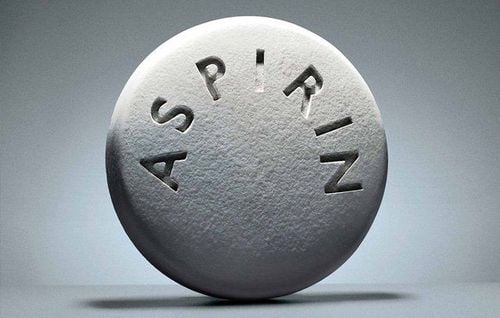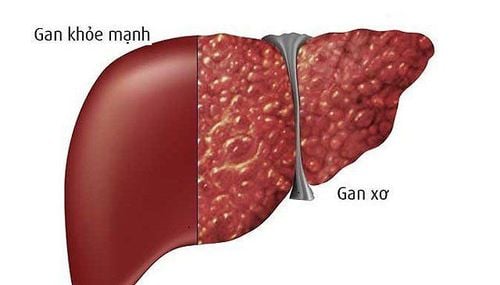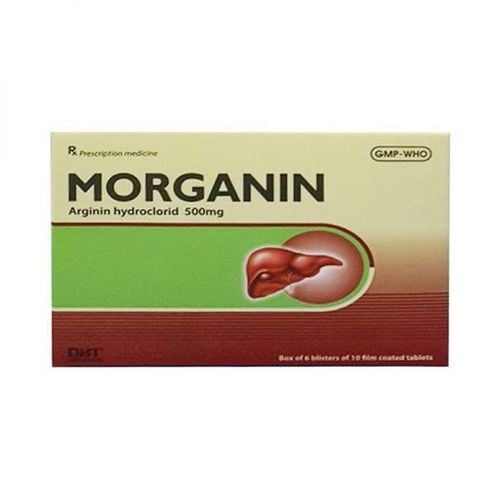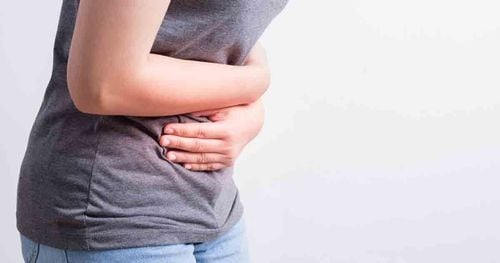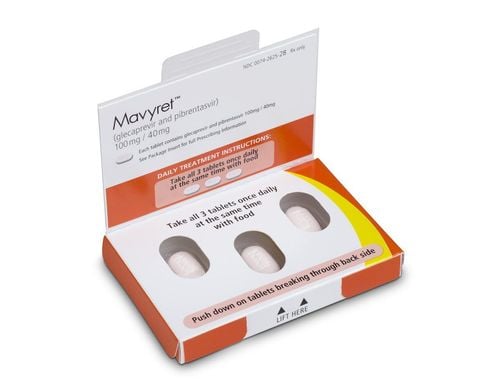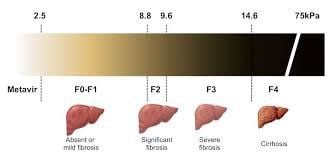This is an automatically translated article.
The article was professionally consulted by Specialist Doctor I Le Nguyen Hong Tram - Gastroenterologist - Department of Medical Examination & Internal Medicine - Vinmec Nha Trang International General Hospital.The liver is not only an organ that metabolizes food, but also helps to remove toxins from the body. When you have cirrhosis or fatty liver, this is a sign that cannot be ignored because it seriously and directly affects the health of each person.
1. What is liver fibrosis?
Liver fibrosis is a condition in which liver cells are damaged continuously for a long time, the normal liver structure will change to abnormal. Progression from early liver damage to cirrhosis can take weeks to years.Some causes of cirrhosis can include: drinking a lot of alcohol, obesity, hepatitis B, chronic hepatitis C, cystic fibrosis, some autoimmune diseases.
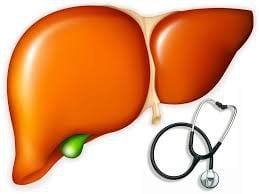
2. Levels of liver fibrosis
Liver fibrosis develops through 4 different stages with increasing levels, and each stage will have different levels of impact on the patient.F1 liver fibrosis: The liver gradually shows signs of damage but has not yet shown too clearly. In the early stages, patients rarely see obvious symptoms because it appears extremely faint. The scar tissue of liver fibrosis is just beginning to form. F2 liver fibrosis: At this stage, the fibrous tissues gradually appear more than in the F1 stage, the liver is much damaged and the signs in the F2 stage are also easier to recognize. At this time, the liver appears more scar tissue, liver fibrosis tissue can be clearly seen through ultrasound and imaging. The amount of liver fibrosis tissue cells in this stage increased greatly, making the liver function significantly impaired. F3 liver fibrosis: When it has progressed to stage 3 cirrhosis, the number of cells with fibrosis is much larger, causing liver dysfunction. The remaining liver cells will have to work harder to filter out toxins for the body, but still cannot meet the needs. Therefore, the patient's body will have obvious signs of edema, jaundice, and feel pain and fatigue throughout the body. F4 cirrhosis: The patient is diagnosed with stage F4 cirrhosis when the liver cells have been completely damaged and the liver can no longer function as it should. This means that the patient is in a very dangerous situation. From the F3 stage onwards, the liver has been severely damaged, causing the patient's body to show serious complications. It is also very difficult to come up with a treatment plan at this time, so if you feel that you are at risk of any liver disease, you need to quickly examine and treat it immediately, to avoid prolonged illness leading to cirrhosis of the liver. Besides, we also need to avoid factors that increase the risk of disease.
Trắc nghiệm: Làm thế nào để bảo vệ lá gan khỏe mạnh?
Làm test trắc nghiệm kiểm tra hiểu biết về gan có thể giúp bạn nhận thức rõ vai trò quan trọng của gan, từ đó có các biện pháp bảo vệ gan để phòng ngừa bệnh tật.3. Process of measuring liver fibrosis and fattyness
Patients need to fast for at least 2 hours before being measured for the stiffness of the liver, the degree of fibrosis.The process of measuring fibrosis and fatty liver is done as follows:
Step 1: The patient lies supine on the bed, right hand raised so that the intercostal space is maximized.
Step 2: The technician places the liver elastography transducer on the patient's skin, in the intercostal space in the right liver area. The patient will feel a slight vibration every time an elastic wave is generated by the vibrator.
Usually the measurement takes between 5 and 10 minutes and causes no pain or discomfort to the patient.
4. Results of assessment of liver fibrosis
Unit: kPaFrom F0 - below F1 (2.5 - 7.4 kPa): Shows no fibrosis or minimal fibrosis with no pathological changes. From F1 - below F2 (7.5 - 9.4 kPa): There are signs of fibrosis in the liver parenchyma and there is a tendency to increase the degree of fibrosis in the next time. From F2 - less than F3 (9.5 - 12.4 kPa): Shows severe fibrosis of liver parenchyma, although it has not yet reached the stage of cirrhosis, there is a risk that it will lead to cirrhosis. From F3 - F4 (from 12.5 kPa or more): shows diffuse liver fibrosis corresponding to the clinical stage of liver fibrosis. Parameters to evaluate the degree of fatty liver:
Unit: dB/m
S0 – below S1 (less than 100 dB/m): there is no accumulation of excess fat in hepatocytes, the number of liver cells containing the Fat particles accounted for less than 5% of the microsphere. From S1 - below S2 (100 - 237.6 dB/m): mild fatty liver, the percentage of hepatocytes containing fat particles is over 5% to < 33%. From S2 - below S3 (237.7 - 259.3 dB/m): moderate fatty liver, the percentage of hepatocytes containing fat particles is from 33% to < 66%.. From S3 - S4 (259.4 - 292.3 dB/m) ) : severe fatty liver, the percentage of hepatocytes containing fat particles is from 66%.
5. Is cirrhosis of the liver dangerous?
Due to the fibrosis of the liver, the scars cannot be restored anymore, so cirrhosis is listed in the "terrible four". However, if early detection and prevention of liver fibrosis continue, liver function and activity will not be affected too much. On the contrary, if not treated in time, the patient will face many dangerous problems.As the number of basic functional units of the liver becomes less and less, the liver's ability to detoxify becomes less and less. Until the liver is unable to prevent toxins from entering the bloodstream, these toxins can enter the brain and cause debilitating mental effects, leading to hepatic encephalopathy. Even when the toxin builds up in the body too much, the patient can faint and go into a coma.
In addition, because the liver plays an important role in the metabolism of estrogen, the patient may also have complications due to increased estrogen in the blood such as: gynecomastia, appearance of spider veins or varicose veins. , palm red lipstick. Not only that, the disease also causes the liver to stop producing clotting factors, leading to dangerous hemophilia.
In addition to the above complications, the disease also leads to other serious complications, which are individually called a disease called ascites.

6. Is cirrhosis curable?
As mentioned above, because the process of fibrosis cannot be reversed, treatment is only limited to the disease not progressing further, but cannot help restore the liver to normal.Theoretically, there is still a method to cure this disease, which is a liver transplant , which means replacing a healthy part of the liver with a damaged part. However, due to the requirement of a liver to replace, in fact, this method is very difficult to implement.
Patients with cirrhosis of the liver can use some drugs that play a role in protecting the liver and promoting health. liver and support liver function. Some groups of drugs commonly used today include:
Drugs that improve the metabolic function of liver cells and glucocorticoid hormones: Prednizolon, Testosterone, Legalon, Vitamin C, B12, Cyanidanol... Infusion: concentrated plasma, 20% albumin solution, synthetic proteins: alvezin, moriami; blood transfusion in case of bleeding,... Medicines to treat ascites: Furocemid (Lasix), Aldacton,... In addition, the patient's diet also needs attention because the liver is a metabolic organ, excrete toxins. If you do not abstinence and have a reasonable diet, it will increase the burden on the liver, causing the disease to turn in a bad direction.
For patients with cirrhosis of the liver, doctors recommend focusing on adding the following food groups: Protein-rich foods (meat, fish, eggs, milk, ..), vitamin-rich foods (fruits). , fish, milk, ...), foods rich in fiber (all vegetables and fruits), foods rich in Beta-carotene such as carrots .., foods rich in Omega-3 (salmon, mackerel, etc.) , tuna,...)
Besides foods that are good for the liver, in order to prevent the disease from getting worse, patients also need to pay attention to some of the following issues:
Stay away from alcohol - one of the causes main cause of the disease. Do not eat too much sugar as it can cause further damage to the liver. Limit salt intake because when damaged, the liver cannot process the sodium in salt, causing swelling and fluid retention. Specialist I Le Nguyen Hong Tram graduated as a Doctor of General Internal Medicine at the University of Medicine and Pharmacy in Ho Chi Minh City. Ho Chi Minh, doctor has many years of experience in the examination and treatment of gastrointestinal diseases, especially gastrointestinal - hepatobiliary diseases, gastrointestinal endoscopy and general internal diseases. Currently, Dr. Tram is working at the Department of Medical Examination and Internal Medicine, Vinmec Nha Trang International General Hospital.
>> See more: The role of herbs in the treatment and prevention of liver fibrosis - Posted by Master, Doctor Mai Vien Phuong - Department of Medical Examination & Internal Medicine - Vinmec Central Park International General Hospital
Please dial HOTLINE for more information or register for an appointment HERE. Download MyVinmec app to make appointments faster and to manage your bookings easily.





